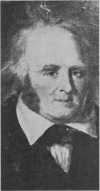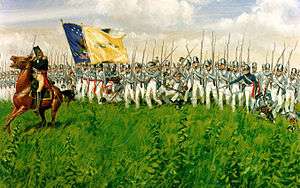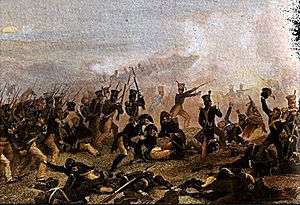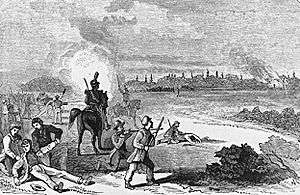William "Tiger" Dunlop
| The Right Honourable William Tiger Dunlop | |
|---|---|
 | |
| Member of Parliament for United Province of Canada. Canada West. Huron. | |
|
In office 1841–1846 | |
| Monarch | Victoria of the United Kingdom |
| Preceded by | Robert Dunlop |
| Majority | Undetermined. James McGill Strachan wins; Dunlop appeals and wins. |
| Personal details | |
| Born |
William Dunlop November 17, 1792 Greenock, Scotland |
| Died |
June 29, 1848 (aged 55) Lachine, Canada or Côte-Saint-Paul (Montreal) |
| Resting place | Hamilton, later Goderich, Upper Canada |
| Citizenship | British |
| Nationality | British |
| Political party | Tory (moderate) |
| Parents | Alexander Dunlop and Janet Graham |
| Education | University of Glasgow |
| Occupation | Military physician, author, woodsman, soldier, politician |
Dr. William Dunlop (19 November 1792 – 29 June 1848) also known as Tiger Dunlop was an army officer, surgeon, Canada Company official, author, justice of the peace, militia officer, politician, and office holder. He is notable for his contributions to the War of 1812 in Canada, his work in the Canada Company and later as a Member of Parliament for the 1st Parliament of the Province of Canada, Canada West, Huron.
Early life and education
Tiger Dunlop was born 19 November 1792 in Greenock, Scotland, the third son of a local banker Alexander Dunlop and Janet Graham. He pursued his medical studies at the University of Glasgow and in London.[1]
In January 1813 Dunlop joined the army as a hospital mate, a month later was posted as an assistant surgeon in the 89th Regiment of Foot. He was first posted to the Isle of Wight, later leaving for Quebec in August 1813. His Canadian experiences can be read in "Recollections of the American War of 1812–1814".[2]
Origins of the nickname "Tiger"
Dunlop was known under a variety of nicknames, but the one that has lasted and remains with him to this day is "Tiger". In Upper Canada, he was also known as The Doctor, Peter Poundtext, or Ursa Major and often as The Backwoodsman.[3]
- The Doctor, of course, is a reference to his professional occupation
- Poundtext is a word play on a type of loan, where no matter the credit rating of the borrower, he may borrow and then repay in seven days.
- Ursa Major is a constellation containing the Big Dipper—another financial reference to Dunlop, but probably more accurate is Ursu Major containing the great bear, a reference to Dunlop’s herculean body.
- The Backwoodsman refers to his life as a frontierman.
The nickname "Tiger" is supposed to have been given to him during his time in India.[3] Some sources describe it as Dunlop participating in a sport; others describe it as a business trip. The combination of two seems to be more inline with Dunlop’s character. The business trip included a cull of the Saugor Island tigers.[4]
Stories of the legend
During his time and certainly after William Tiger Dunlop became a legend. It was common for people to seek him out just for the pleasure of having been said to have met Tiger Dunlop. The stories that surrounded him became the stuff of legend; some verifiable, some not.
Impersonating a general
Dunlop and a fellow army friend had been ordered to join their regiment on the Niagara frontier two hundred and eighty miles from their present location in Kingston. Although the road from Kingston to Niagara had many post houses, they were not well supplied and junior officers came in low in the pecking order. It became common for Dunlop and friend to find worn out nags available as their transportation. Being in a hurry, the two men decided to speed up the process and gave themselves instant promotions. Dunlop became a major-general and the friend became his aide. The “aide” demanded good horses for his general who had apparently been sent by the Duke of Wellington to instruct Sir Gordon Drummond on how to conduct the campaign. With no shortage of the theatrical in their nature, the imposters pulled off the hoax and rode good horses. Dunlop was twenty-two at the time.[5]
Regiment of the Bloody Useless
During the Rebellions of 1837, William Dunlop, who had become a Colonel, was requested to raise a militia unit that would become known as the 1st Regiment Huron Militia. The Regiment consisted of some 600 badly outfitted and ill-equipped men. The Regiment experienced great difficulty obtaining even the most rudimentary supplies according to the Memorial by Lieutenant-Colonel Taylor 1st Regiment Huron Militia to the House of Assembly of the Province of Upper Canada in Provincial Parliament Assembled. Dunlop nicknamed the militia unit "The Bloody Useless."[2] Little wonder that the 1st Regiment Huron Militia played no significant role in any of the activities of the Rebellions. Notwithstanding that Dunlop was still an employee of the Canada Company while engaged in this Militia activity, Dunlop took it upon himself to commandeer supplies and food from the Canada Company so that his soldiers could eat and defend themselves.[3]
Marriage
William and his brother Robert shared a home near Goderich, Ontario at Gairbraid. Being both bachelors and unaccustomed to domestic work, they sent home to Scotland for a housekeeper. Louisa McColl arrived in Canada to take care of the two brothers. Shortly after, tongues began wagging and it soon became clear that Louisa’s situation was insupportable and she would need to either marry or leave the country. Robert and William decided McColl was irreplaceable and tossed a coin to see which brother would marry Louisa.[1] William supplied the coin and Robert lost the toss; after the wedding it became known that William had supplied a coin with the same face on both sides. Robert never objected.[3]
Gairbraid is now known as Saltford, Ontario.
Crossing the US border
Dunlop was fond of snuff, a tobacco product. Like any other consumable, Dunlop enjoyed snuff in large quantities. The box in which he carried his snuff, he called The Coffin. Crossing the Canada/US border, a US inspector found it doubtful that the amount of snuff carried with him was just for personal use. Dunlop is said to have tossed a handful of snuff in the air, then snorting it as it fell around him. He said: “There, that’s what I want it for; that’s the way I use it".[3]
Nails in a barrel
Enjoying a good practical joke, Dunlop and a friend were passing the time in a Goderich store. A porcupine had been deposited in a barrel normally used for nails. As each person came into the store Dunlop would request help in getting a few nails. Dunlop’s delight in shocking was spontaneous.[3]
Life in Canada
War of 1812
Upon leaving Britain on the 4th of February 1813, he was appointed assistant surgeon to the 89th (The Princess Victoria's) Regiment of Foot. The regiment was posted to Upper Canada during the War of 1812 in time to participate in the Battle of Crysler's Farm and the Battle of Lundy's Lane.


Like other war doctors, Dunlop was faced with seemingly impossible tasks. After the Battle of Chippawa, Dunlop worked alone on 220 men from both armies because no other surgeons were available. The story continues that Dunlop worked alone for more than two full days, barely sitting down and stopping only to eat and change clothes.[6] He played a more active role in the assault on Fort Erie on 15 August 1814, carrying about a dozen injured men out of the range of fire and providing survivors with basic necessities. He served with a road-cutting party near Penetanguishene in the spring of 1815.[1]
Rebellions of 1837

During the Rebellions of 1837, Dunlop commanded the Huron Regiment in Upper Canada nicknamed The Bloody Useless. The rebellion was short-lived and led by the radicals fighting for responsible government. The Huron Regiment consisted of approximately 600 men with primitive arms and few resources.[2] Dunlop commandeered supplies and food from Canada Company stores for the benefit of his men, leading to demands from the Canada Company for his withdrawal from militia activities. Dunlop refused, but resigned from the company later in 1838.[1]
Tiger Dunlop was Colonel and 1st Commanding Officer of the 1st Regiment Huron Militia. Dunlop called out the unit in December 1837. The regiment was made up of Colborne men with the surrounding townships supplying many of the men. Dunlop drilled his men in Read's Tavern while scavenging for blankets, coats, boot and more.[5]
Colonel Dunlop had five company commanders: Henry Hyndman, Thomas W. Luard, W.F.Gooding, Daniel Home Lizars, and Captain Annand. Late in December the government dispatches orders to the 1st Hurons and on December 25 Dunlop dispatches as follows:
- Hyndman's Company to Walpole Island on the St. Clair frontier
- W.F.Gooding near Sarnia
- Luard at Navy Island
- Lizars at Clinton
- Captain Annand as home guard at Goderich, Ontario.[5]
Unprepared and poorly managed as the rebels were, the Rebellion of 1837 Upper Canada was quickly over. The Regiment of the Bloody Useless saw no action. Dunlop worked fiercely to ensure that his men were paid for their three months of service.
The Canada Company
In 1825 Tiger Dunlop was appointed Warden of the Woods and Forests by John Galt of the Canada Company. The position involved inspecting the company lands to protect them and the selection of land to be sold for profit. This position put Tiger Dunlop as second-in-command to Galt in Upper Canada of 1825. In 1829, Galt resigned his position. As was the custom of the day, positions such as that held by Dunlop were personal appointments − he was in some danger of losing his position, but managed to keep it. In 1833 he was appointed the General Superintendent of the Huron Tract. It was at this time that Dunlop published Statistical Sketches of Upper Canada to encourage young people to come to Canada.[7]
Tiger was present at the founding of Guelph, the company headquarters for the Canada Company, and built his home north of Goderich.
Member of Parliament, Province of Canada
Tiger Dunlop left the Canada Company in 1838. Three years later his brother Robert Graham Dunlop died leaving his parliamentary seat vacant. The seat was contested both by a Canada Company official, James McGill Strachan and Tiger Dunlop. Tiger was declared not elected. Tiger appealed the election results and won. On the appeal being allowed, he took his seat 20 August 1841. Tiger was a colourful character and made interesting speeches and wrote direct letters to the newspapers of Toronto. Dunlop's short foray into journalism gave him the knowledge of the trade to catch the eyes of the editors in London, England.
When Dunlop resigned from the Canada Company the divisions in Huron County became more evident where the Canada Company provided some with a living and others with obstacles to overcome. Dunlop became the natural leader of a group known as the Colbornites, an anti-Company group.
In February 1841 Robert Dunlop, who had represented Huron in the assembly since 1835, died. The union of Upper and Lower Canada took place shortly after Robert Dunlop's death. In the subsequent election later that year William ran against the Canada Company’s choice, James McGill Strachan, son of the bishop and brother-in-law of Thomas Mercer Jones. Although Strachan had had little chance of winning, he was declared elected. Dunlop's subsequent appeal was successful and he was awarded the seat. In the general election of 1844 Dunlop ran unopposed.[8]
Despite his flamboyant character and occasional radical stances, in the legislature Dunlop took a moderate tory position. He became notable for his humour. In 1841 he chaired a committee to hear the grievances of the exiled radical Robert Fleming Gourlay. Dunlop's report was an even-handed treatment of Gourlay's situation[3]
Voting record
Dunlop’s record as a parliamentarian demonstrates that he did not vote along party lines. This is not an exhaustive list, but a list that is meant to provide some insight into the thought and ideology of a man of contradictions who genuinely spans the Tory to Reform spectrum in the early days of Canada.
- Education – always voted to improve schooling for the general public.[9]
- Secular university to replace the Anglican King’s College; later known as the University of Toronto. Voted yes.[10]
- Choice of Speaker of the House 1844 – Voted for a bilingual member to take the position.[11]
- Should magistrates be lawyers? – Voted no.[12]
- The lawful use of corpses to facilitate the study of anatomy – Voted yes.[13]
- Customs union with the British West Indies – Voted yes.[10]
- Forbidding of processions by private societies; aimed at the Orange Lodge. – Voted yes.[10]
1st Warden of the District of Huron

As a member of Parliament, Dunlop was appointed as the 1st Warden of the District of Huron. With his experience as the Canada Company Warden of the Woods,[14] Dunlop was uniquely qualified for this work. However, his methods often left questions in the minds of those around him and he was replaced in 1846.[3]
Resignation
Tiger resigned his seat in 1846. It is not clear why he did so. However, two reasons are generally cited for the resignation; health and alcohol. The years spent living in the primitive forests of Canada and the ever increasing use of alcohol appear to have taken a toll. William Tiger Dunlop was a tired and sick man.[5] Tiger was not taken seriously in Parliament or in the newspaper editorials of the day. Unfortunately, the two political concepts of the Parliament of Canada that he could not absorb were responsible government and the concept of group or social liberty. Dunlop firmly believed in individual liberty and in patronage. Moreover, Dunlop was far ahead of his time on other issues, such as education, professional independence, commerce and the rights of French Canadians.[5] Dunlop was tired of the fight and the irrelevant place he had carved for himself in Parliament with his outspokenness.
Tory ministers William Henry Draper and Denis-Benjamin Viger apparently wanted their colleague Inspector General William Cayley to have a safe seat in parliament and looked to Huron. Dunlop was offered the superintendency of the Lachine Canal in return for his seat. To the surprise of all, Dunlop accepted the post.[3] Tiger Dunlop died within two years of leaving the legislature on 29 June 1848, at the age of 56 and was buried first in Hamilton and then in Goderich, Upper Canada.
Plaque

Text from the Tiger Dunlop Plaque, which can be found near his gravesite in Goderich, Ontario.

- "In the nearby tomb is buried Dr. William Dunlop, physician, author, woodsman, soldier, politician and raconteur. Born in Scotland, he served in Canada as an army surgeon during the War of 1812. His writings, including articles based on his residence in India 1817–1819, won him a place among the witty contributors to Blackwood's Magazine with the title of 'Tiger'. In 1826 he emigrated to Upper Canada. As 'Warden of the Forests' for the Canada Company, he assisted John Galt in opening up the Huron Tract and in 1827 founded Goderich. Dunlop was member for Huron 1841–46 and wrote two books about Canada."
Works
Dunlop's writing are best known for their depiction of Canadian frontier life in the Huron Tract. Dunlop wrote the following works under both the Backwoodsman and William Dunlop:[15]
- Recollections of the American war, 1812-14 by Dr. Dunlop ; with a biographical sketch of the author, by A.H.U. Colquhoun Dunlop, William, 1792-1848 Toronto : Historical Publishing Co., 1908.
- Dunlop, William, 1792-1848. Statistical sketches of Upper Canada : for the use of emigrants by a backwoodsman. -- London : J. Murray, 1832.
- Backwoodsman. Two and twenty years ago : a tale of the Canadian Rebellion by a backwoodsman. 1859 Toronto : Cleland's Book and Job Printing House
- Dunlop, William, 1792-1848. Statistical sketches of Upper Canada : for the use of emigrants by a backwoodsman. 3rd ed. -- London : J. Murray, 1833.
- Backwoodsman. The Vagary, or, The last labors of a great mind compiled frow original documents ; with an appendix ... ; adapted to the times by a backwoodsman. -- Conneautville, Pa., 1856 Conneautville, Pa. : A.J. Mason
- Dunlop, William, 1792-1848. Lands in the Huron district. Toronto : Rowsells & Thompson
- Dunlop, William, 1792-1848. An address delivered to the York Mechanics' Institution, March, 1832 by Dr. Dunlop. -- York [Toronto] : Printed for the Mechanics' Institution at the Guardian Office, 1832 (York [Toronto] : W.J. Coates)
- Dunlop, William, 1792-1848. To the freeholders of the county of Huron : my friends and neighbours, it was only yesterday that I saw by accident, in an obscure print, the name of which I never before heard, an attack upon me by Mr. Morgan Hamilton. -- [Upper Canada, 1841]
- Upper Canada by a backwoodsman. London : John Murray, 1832
Bibliography
- Byfield, Shadrach, b. 1789. Two British Soldiers in the War of 1812 : the accounts of Shadrach Byfield and William Dunlop Edited and annotated by Stuart Sutherland. -- Toronto : Iser Publications, 2002.
- Coleman, Thelma. The Canada Company by Thelma Coleman ; and James Anderson for supplement and the search for illustrations. -- Stratford, Ont. : County of Perth : Perth County Historical Board : Cumming Publishers, c1978.
- Dunlop, William, 1792-1848. Recollections of the American war, 1812-14 by Dr. Dunlop ; with a biographical sketch of the author, by A.H.U. Colquhoun. -- Toronto : Historical Pub. Co., 1905.
- Dunlop, William, 1792-1848. Tiger Dunlop's Upper Canada : comprising Recollections of the American War 1812-1814, and Statistical sketches of Upper Canada for the use of emigrants by a backwoodsman / introd., Carl F. Klinck. -- Toronto : McClelland and Stewart, c1967.
- Dunlop, William, 1792-1848. William Tiger Dunlop, Blackwoodian backwoodsman / essays by and about Dunlop selected and edited by Carl F. Klinck. -- Toronto : Ryerson Press, 1958.
- Ford, F. S. L. (Frederick Samuel Lampson), 1869-. William Dunlop / by F.S.L. Ford. -- Toronto : Murray, 1931.
- Ford, Frederick Samuel Lampson, 1869-. William Dunlop. [Ed. 2.] -- Toronto, Britnel, 1934.
- Graham, W. H. (William Hugh), 1912-. The Tiger of Canada West / W.H. Graham. -- Toronto : Clarke, Irwin, 1962.
- Klinck, Carl Frederick, 1908-. William "Tiger" Dunlop, "Blackwoodian backwoodsman" ; essays by and about Dunlop. -- Toronto Ryerson Press [1958]
- Stewart, I. Anette. The 1841 election of Dr. William Dunlop as member of parliament for Huron County.—1947.
- Tazewell, Samuel Oliver, fl. 1833-1835. Portrait of William Dunlop / Tazewell delt. & lithr. -- York, U.C. : Published for the Canadian literary magazine, [1833]
See also
- List of cities and towns of Upper Canada
- The Canadas
- Former colonies and territories in Canada
- Timeline of Ontario history
- Canadian Boat-Song
References
- 1 2 3 4 "William Tiger Dunlop". herontrips.com. Retrieved July 16, 2010.
- 1 2 3 "WILLIAM DUNLOP 1792–1848". Canadian Medical Association Journal. 25 (2): 210. PMC 382623
 .
. - 1 2 3 4 5 6 7 8 9 "Dictionary of Canadian Biography Online". biographi.ca. Retrieved July 16, 2010.
- ↑ Draper, Gary (Spring–Summer 1980). Bentley, D.M.R., ed. "Tiger Dunlop and the Canadian Boat Song.". Canadian Poetry: An Electronic Resource. University of Western Ontario Canadian Poetry Press (06). Retrieved July 28, 2010.
- 1 2 3 4 5 W.H.Graham, The Tiger of Canada West, Clark, Irwin & Co.,1962,pp.24-25.
- ↑ "The War of 1812". galafilm.com. Retrieved July 16, 2010.
- ↑ "Dunlop, William - The Canadian Encyclopedia". thecanadianencyclopedia.com. Retrieved July 16, 2010.
- ↑ Stewart, I. Anette. The 1841 election of Dr. William Dunlop as member of parliament for Huron County. Toronto Ryerson Press [1958].
- ↑ The Examiner, 5 March 1845.
- 1 2 3 The Montreal Transcript, 10 October 1843
- ↑ The British Colonist, 26 November 1844.
- ↑ The Examiner, 8 November 1843.
- ↑ Toronto Patriot, 27 October 1843
- ↑ "History of the County of Bruce, Ontario, Canada. The Infant County, 1850-1856=electricscotland.com". Retrieved July 30, 2010.
- ↑ "William Tiger Dunlop". Retrieved 2011-03-29.
External links
- Library and Archives Canada: From Colony to Country: A Reader's Guide to Canadian Military History
- Works by William Dunlop at Project Gutenberg
- Works by or about William Dunlop at Internet Archive